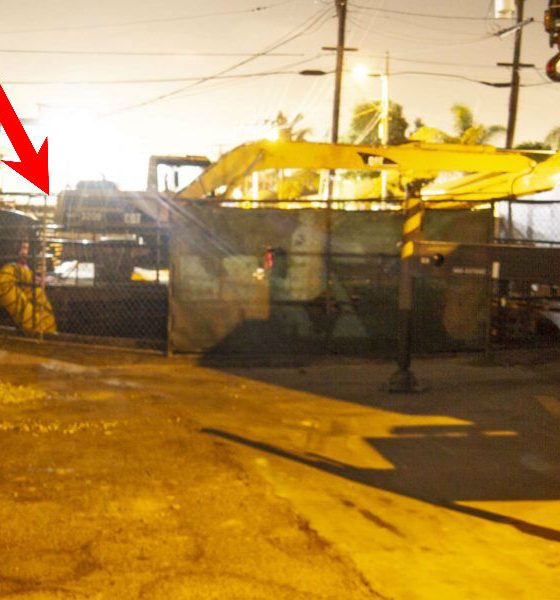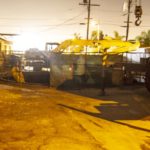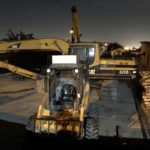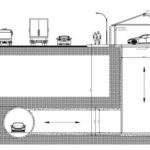

News
Elon Musk’s Boring Company breaks ground for garage-elevator construction
Last month, Elon Musk’s tunneling startup, The Boring Company, was granted an approval by the city council of Hawthorne, CA to build a prototype garage-elevator concept that would be linked to one of the company’s high-speed tunnels. Recent photos from Teslarati photographers Tom Cross and Pauline Acalin reveal that construction of the prototype elevator concept has already begun.
The Boring Company’s prototype garage-elevator is being built west of SpaceX’s Hawthorne facility. The location of the futuristic garage is no accident, as the startup plans to have cars enter the tunnel from the SpaceX campus, move through the tunnel and on to the garage-elevator, and then travel back to SpaceX as part of the concept’s tests. Adopting such a process allows The Boring Co. to avoid creating additional traffic on the street.
Photos captured by Teslarati photographers reveal that The Boring Company has broken ground on the site of its recently-announced garage-elevator. While the startup has not officially announced that the construction corresponds to the planned elevator concept, the site’s location on 120th St. near Prairie Avenue matches the address of the project that the company confirmed to The Mercury Times last month. Furthermore, the pit’s sheer scale fits well with the company’s plans to dig a hole to extract segments of its tunnel boring machine (TBM).
- The excavation site of the Boring Company’s garage-elevator prototype. [Credit: Tom Cross/Teslarati]
- The excavation site of the Boring Company’s garage-elevator prototype. [Credit: Tom Cross/Teslarati]
- The excavation site of the Boring Company’s garage-elevator prototype. [Credit: Pauline Acalin/Teslarati]
The site of the Boring Company’s excavation for its garage-elevator prototype. [Credit: Tom Cross and Pauline Acalin/Teslarati]
Looking at the images of the construction in progress, it appears that the hole being excavated is around 30 feet or more in diameter. This is quite substantial, considering that graphics provided by the tunneling startup show the garage-elevator transporting cars one at a time. As noted by AutomobileElevator, a company in the business of providing car elevators, lifts that are designed for large vehicles like full-sized SUVs usually have dimensions of 9.3 x 20 x 7 feet – significantly smaller than the pit in the Boring Company’s ongoing excavation. With this in mind, it appears that the tunneling startup’s garage-elevator, once complete, would have enough space to accommodate large mainstream vehicles like full-sized SUVs and trucks.
- The Boring Company’s proposed prototype garage. [Credit: The Boring Company]
- The Boring Company’s proposed prototype garage. [Credit: The Boring Company]
The Boring Company’s proposed prototype garage-elevator concept. [Credit: The Boring Company]
In a comment about the garage-elevator, Boring Company representative Jane Labanowski noted that the prototype concept would be an essential part of the tunneling startup’s vision for the future. The garage-elevator, if any, would serve as convenient entry point for the company’s high-speed tunnel system, particularly for those in residential areas.
“It’s an important part of the longer-term vision the company is trying to build,” she said.
The Boring Company might be a newcomer in the transportation industry that is more well-known for its quirky merchandise such as the Boring Company Not-a-Flamethrower, but the tunneling startup is already starting to gain contracts for high-profile projects. Earlier this year, for example, the Boring Company won a contract for the construction of the downtown Chicago-O’Hare high-speed transport line, beating larger, more experienced conglomerates which were also bidding on the project. The Chicago project would feature the Loop system, which features Tesla-made fully-electric pods capable of transporting up to 16 people at a time at speed of up to 150 mph.

Elon Musk
Elon Musk and Tesla AI Director share insights after empty driver seat Robotaxi rides
The executives’ unoccupied tests hint at the rapid progress of Tesla’s unsupervised Robotaxi efforts.

Tesla CEO Elon Musk and AI Director Ashok Elluswamy celebrated Christmas Eve by sharing personal experiences with Robotaxi vehicles that had no safety monitor or occupant in the driver’s seat. Musk described the system’s “perfect driving” around Austin, while Elluswamy posted video from the back seat, calling it “an amazing experience.”
The executives’ unoccupied tests hint at the rapid progress of Tesla’s unsupervised Robotaxi efforts.
Elon and Ashok’s firsthand Robotaxi insights
Prior to Musk and the Tesla AI Director’s posts, sightings of unmanned Teslas navigating public roads were widely shared on social media. One such vehicle was spotted in Austin, Texas, which Elon Musk acknowleged by stating that “Testing is underway with no occupants in the car.”
Based on his Christmas Eve post, Musk seemed to have tested an unmanned Tesla himself. “A Tesla with no safety monitor in the car and me sitting in the passenger seat took me all around Austin on Sunday with perfect driving,” Musk wrote in his post.
Elluswamy responded with a 2-minute video showing himself in the rear of an unmanned Tesla. The video featured the vehicle’s empty front seats, as well as its smooth handling through real-world traffic. He captioned his video with the words, “It’s an amazing experience!”
Towards Unsupervised operations
During an xAI Hackathon earlier this month, Elon Musk mentioned that Tesla owed be removing Safety Monitors from its Robotaxis in Austin in just three weeks. “Unsupervised is pretty much solved at this point. So there will be Tesla Robotaxis operating in Austin with no one in them. Not even anyone in the passenger seat in about three weeks,” he said. Musk echoed similar estimates at the 2025 Annual Shareholder Meeting and the Q3 2025 earnings call.
Considering the insights that were posted Musk and Elluswamy, it does appear that Tesla is working hard towards operating its Robotaxis with no safety monitors. This is quite impressive considering that the service was launched just earlier this year.
Elon Musk
Starlink passes 9 million active customers just weeks after hitting 8 million
The milestone highlights the accelerating growth of Starlink, which has now been adding over 20,000 new users per day.

SpaceX’s Starlink satellite internet service has continued its rapid global expansion, surpassing 9 million active customers just weeks after crossing the 8 million mark.
The milestone highlights the accelerating growth of Starlink, which has now been adding over 20,000 new users per day.
9 million customers
In a post on X, SpaceX stated that Starlink now serves over 9 million active users across 155 countries, territories, and markets. The company reached 8 million customers in early November, meaning it added roughly 1 million subscribers in under seven weeks, or about 21,275 new users on average per day.
“Starlink is connecting more than 9M active customers with high-speed internet across 155 countries, territories, and many other markets,” Starlink wrote in a post on its official X account. SpaceX President Gwynne Shotwell also celebrated the milestone on X. “A huge thank you to all of our customers and congrats to the Starlink team for such an incredible product,” she wrote.
That growth rate reflects both rising demand for broadband in underserved regions and Starlink’s expanding satellite constellation, which now includes more than 9,000 low-Earth-orbit satellites designed to deliver high-speed, low-latency internet worldwide.
Starlink’s momentum
Starlink’s momentum has been building up. SpaceX reported 4.6 million Starlink customers in December 2024, followed by 7 million by August 2025, and 8 million customers in November. Independent data also suggests Starlink usage is rising sharply, with Cloudflare reporting that global web traffic from Starlink users more than doubled in 2025, as noted in an Insider report.
Starlink’s momentum is increasingly tied to SpaceX’s broader financial outlook. Elon Musk has said the satellite network is “by far” the company’s largest revenue driver, and reports suggest SpaceX may be positioning itself for an initial public offering as soon as next year, with valuations estimated as high as $1.5 trillion. Musk has also suggested in the past that Starlink could have its own IPO in the future.
News
NVIDIA Director of Robotics: Tesla FSD v14 is the first AI to pass the “Physical Turing Test”
After testing FSD v14, Fan stated that his experience with FSD felt magical at first, but it soon started to feel like a routine.

NVIDIA Director of Robotics Jim Fan has praised Tesla’s Full Self-Driving (Supervised) v14 as the first AI to pass what he described as a “Physical Turing Test.”
After testing FSD v14, Fan stated that his experience with FSD felt magical at first, but it soon started to feel like a routine. And just like smartphones today, removing it now would “actively hurt.”
Jim Fan’s hands-on FSD v14 impressions
Fan, a leading researcher in embodied AI who is currently solving Physical AI at NVIDIA and spearheading the company’s Project GR00T initiative, noted that he actually was late to the Tesla game. He was, however, one of the first to try out FSD v14.
“I was very late to own a Tesla but among the earliest to try out FSD v14. It’s perhaps the first time I experience an AI that passes the Physical Turing Test: after a long day at work, you press a button, lay back, and couldn’t tell if a neural net or a human drove you home,” Fan wrote in a post on X.
Fan added: “Despite knowing exactly how robot learning works, I still find it magical watching the steering wheel turn by itself. First it feels surreal, next it becomes routine. Then, like the smartphone, taking it away actively hurts. This is how humanity gets rewired and glued to god-like technologies.”
The Physical Turing Test
The original Turing Test was conceived by Alan Turing in 1950, and it was aimed at determining if a machine could exhibit behavior that is equivalent to or indistinguishable from a human. By focusing on text-based conversations, the original Turing Test set a high bar for natural language processing and machine learning.
This test has been passed by today’s large language models. However, the capability to converse in a humanlike manner is a completely different challenge from performing real-world problem-solving or physical interactions. Thus, Fan introduced the Physical Turing Test, which challenges AI systems to demonstrate intelligence through physical actions.
Based on Fan’s comments, Tesla has demonstrated these intelligent physical actions with FSD v14. Elon Musk agreed with the NVIDIA executive, stating in a post on X that with FSD v14, “you can sense the sentience maturing.” Musk also praised Tesla AI, calling it the best “real-world AI” today.













